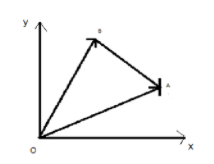Answer
396.9k+ views
Hint: A quantity having magnitude as well as direction is known as vector, necessary for finding the position of one point in space with respect to others. Vectors are represented by a line symbol \[ \to \]on the top of the variable that determines the magnitude and direction of the quantity.
Position vector is used to describe the position of a point relative to a point and as the point moves the position vector will change its direction or the length or the both. Position vector is described for a straight line whose one end is fixed to a body and the other end is a moving point. A position vector is also known as the location vector or the radius vector.
In this question we have to find the position vector of \[\overrightarrow {OA} \] by using the triangle law of addition of the vector.
Complete step by step solution: Given the vectors
\[\overrightarrow {AB} = 2\hat i - \hat j + \hat k\]
\[\overrightarrow {OB} = 3\hat i - 4\hat j + 4\hat k\]

The position vector of \[\overrightarrow {OA} \]the straight line point where \[O\]is a fixed point and \[A\]is the moving point, here the vectors make a triangle hence we will use triangle law of vector addition which states when the two sides of triangle represent magnitude and direction then its third side will represent the magnitude and direction of their sum hence we can write \[\overrightarrow {OA} = \overrightarrow {AB} + \overrightarrow {OB} \], so the position vector of \[\overrightarrow {OA} \] is equal to
\[
\overrightarrow {OA} = \overrightarrow {AB} + \overrightarrow {OB} \\
= 2\hat i - \hat j + \hat k + 3\hat i - 4\hat j + 4\hat k \\
= \left( {2 + 3} \right)\hat i + \left( { - 1 - 4} \right)\hat j + \left( {1 + 4} \right)\hat k \\
= 5\hat i - 5\hat j + 5\hat k \\
\]
Hence the position vector of \[\overrightarrow {OA} \] \[ = 5\hat i - 5\hat j + 5\hat k\]
Note: Resultant of a vector is the sum of two or more vectors it is the result of adding two or more vectors where if displacement vectors are added then the result is the resultant vector.
Position vector is used to describe the position of a point relative to a point and as the point moves the position vector will change its direction or the length or the both. Position vector is described for a straight line whose one end is fixed to a body and the other end is a moving point. A position vector is also known as the location vector or the radius vector.
In this question we have to find the position vector of \[\overrightarrow {OA} \] by using the triangle law of addition of the vector.
Complete step by step solution: Given the vectors
\[\overrightarrow {AB} = 2\hat i - \hat j + \hat k\]
\[\overrightarrow {OB} = 3\hat i - 4\hat j + 4\hat k\]

The position vector of \[\overrightarrow {OA} \]the straight line point where \[O\]is a fixed point and \[A\]is the moving point, here the vectors make a triangle hence we will use triangle law of vector addition which states when the two sides of triangle represent magnitude and direction then its third side will represent the magnitude and direction of their sum hence we can write \[\overrightarrow {OA} = \overrightarrow {AB} + \overrightarrow {OB} \], so the position vector of \[\overrightarrow {OA} \] is equal to
\[
\overrightarrow {OA} = \overrightarrow {AB} + \overrightarrow {OB} \\
= 2\hat i - \hat j + \hat k + 3\hat i - 4\hat j + 4\hat k \\
= \left( {2 + 3} \right)\hat i + \left( { - 1 - 4} \right)\hat j + \left( {1 + 4} \right)\hat k \\
= 5\hat i - 5\hat j + 5\hat k \\
\]
Hence the position vector of \[\overrightarrow {OA} \] \[ = 5\hat i - 5\hat j + 5\hat k\]
Note: Resultant of a vector is the sum of two or more vectors it is the result of adding two or more vectors where if displacement vectors are added then the result is the resultant vector.
Recently Updated Pages
Basicity of sulphurous acid and sulphuric acid are

Assertion The resistivity of a semiconductor increases class 13 physics CBSE

The Equation xxx + 2 is Satisfied when x is Equal to Class 10 Maths

What is the stopping potential when the metal with class 12 physics JEE_Main

The momentum of a photon is 2 times 10 16gm cmsec Its class 12 physics JEE_Main

Using the following information to help you answer class 12 chemistry CBSE

Trending doubts
Difference Between Plant Cell and Animal Cell

Difference between Prokaryotic cell and Eukaryotic class 11 biology CBSE

Fill the blanks with the suitable prepositions 1 The class 9 english CBSE

Change the following sentences into negative and interrogative class 10 english CBSE

Summary of the poem Where the Mind is Without Fear class 8 english CBSE

Give 10 examples for herbs , shrubs , climbers , creepers

Write an application to the principal requesting five class 10 english CBSE

What organs are located on the left side of your body class 11 biology CBSE

What is the z value for a 90 95 and 99 percent confidence class 11 maths CBSE



